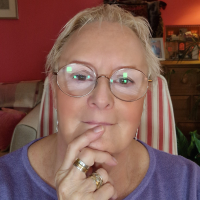
Catherine’s in trouble. It’s 3am and it’s about to happen again.
She can already feel it building and she knows, with a pang of fear and dread that grips her like an iron fist around her heart—merciless and cruel and gloating—that within just a few seconds she will be beyond help.
The heat’s rising, tingling and fizzing through her body, she can hear her blood pounding as she holds her breath in awful anticipation of what’s to come. Every muscle tightens until she’s her body’s prisoner, until this thing that’s now inevitable finally overpowers her.
She’s sweating now, and the constriction’s getting closer. The paralysis is almost absolute: she can’t swallow, she can’t cry out, she can’t move.
And then the wave hits, just as she knew it would.
It is a terrifying and ferocious wave, battering both her body and her mind. As it hits she can no longer get her breath because there is no air in her lungs.
Catherine is once again sure that this time she must surely die.
Catherine’s lived with this terror all her life, but today it’s particularly acute.
She’s in a hotel room in Tokyo, thousands of miles away from home, on a business trip by invitation to deliver a keynote lecture at a prestigious event and in this moment it seems impossible that she will make it through the next moment…let alone the day to come.
She’s being swept straight into the eye of the terrifying tidal wave we call a panic attack.
And then, at the last minute, just as the tide is about to swallow her and carry her away, she remembers.
With seconds to spare, she hears her therapist’s voice, calm and reassuring and certain. She grabs hold of a rock just in time to connect back with safety before being swept out to sea.
The voice becomes her own, and suddenly, she’s hauling herself back onto dry land.
What she heard her therapist’s voice say was:
“This is a memory feeling…only a memory feeling. It feels like it’s happening right now. It feels very real. But it’s memory only. Breathe…Loosen…Soften. You don’t need to fight, you’re safe. It’s in the past, come back to now. Let it go, let it go…just breathe. Breathe out. Out.”
Catherine is calming now. She’s doing what she’s been taught, feeling the carpet beneath her feet, listening to the sounds in the room. The clock, the radiator, her feet moving on the asset. Her own breathing.
Most of all, her own breathing.
Gradually, her chest is feeling less tight and constricted, as she releases the air that had filled her lungs to capacity, making her feel as if she couldn’t get air. She’s remembering that it was because she’d been gasping in small breaths and forgetting to breathe out. She releases the tension, and feels her whole body begin to relax.
At last!
Catherine’s a professional woman, highly thought-of and respected in her field. She travels the world researching, writing, lecturing. And yet, there’s one thing that can lead her to feel terrified to the point of a panic attack: separation from those she loves.
Let me tell you a little more about Catherine and, in the process, a little more about memory feelings and how panic attacks are triggered.
Understanding what’s going on in our memory can really help, as can the discovery that we can control the physiological symptoms that have been triggered once we join everything up.
So here goes:
When Catherine was just two years old, something happened that has stayed in her memory banks unprocessed for nearly fifty years. Everything in her young life changed because her mum became severely ill and had to be taken into hospital. She was in and out of hospital thereafter for two years.
Catherine just came home one day, having been collected from a friend’s house by her grandmother instead of her mother as she’d expected and when she got home, her mum had gone. Her mum was in and out of intensive care and the family decided that visiting would be too frightening for Catherine.
Catherine knew something was seriously wrong.
She picked it up in the lowered voices, worried looks, occasional tears all around her, and in the way the mood in her home had changed. She was filled with childish fears (that no-one knew how to help with) and the pain of missing her mum and believing she was gone forever was something she held in her body and couldn’t begin to know how to share.
Over time, we suppress memories like these.
They don’t have to be as dramatic; nor do they have to even be as significant. Alternatively, they might be more severe.
Any feeling or experience we go through when we’re too young to process it properly is stored in its raw state: a mixture of fear and frightening bodily sensation. It’s the sensations we actually dread.
And so suppressing feelings can become our default coping strategy. And as time goes on, we suppress more and more feelings and experiences until, as adults we continue that same strategy and experience panic.
So let’s pull all this together and tease out the key points:
1. A panic attack is a severe fight or flight response in the body.
2. It’s triggered when something happening now triggers something that happened back then.
3. Physiologically, we bring on a panic attack when we hold our breath, or breathe shallowly and quickly, and tense our muscles tight.
4. We believe we can’t breathe because we’re trying to breathe in when actually we need to breathe out.
5. We believe we can’t move even when we can because we’re holding our muscles rigid.
6. We’re caught in the glare of the headlights of a past event we might not even remember. What it was doesn’t matter. What does matter is knowing it’s memory and reminding ourselves to come back to now.
7. We need to do everything we can to feel safe and grounded in now. Sounds, textures, our breath, our heartbeat, telling ourselves this is memory only, that we are safe, that in this moment nothing bad is happening.
8. Once we start to calm we need to move. Stretch or shake it all out. Anything to prove to ourselves that the paralysis was memory only. And we need to keep breathing out and checking we’re no longer holding our breath or tensing up. To reassure ourselves that we’re free now and safe.
9. Then we need to restore ourselves: a warm drink, something to raise our blood sugar, a hug or a blanket, or fresh air and bare feet on the ground, a walk in nature, music, a nap—whichever works for us.
10. And finally we need to celebrate our true power and what we’ve just managed to do!
It can be summed up like this:
• Breathe — out, again and again.
• Release — move, let go the tension, loosen up.
• Return — come back to now. Do whatever helps to reconnect to where you are now and to reassure yourself that nothing is going wrong here and now. Tell yourself that this is memory only and you are safe.
I wish for you freedom from the past, peace in your now and trust in yourself so that, like Catherine, you can finally taste your true power.
~
Relephant:
Why I am Thankful for my Panic Attacks.
~
Author: Janny Juddly
Editor: Sarah Kolkka
Image: wackystuff/flickr and nemke/shutterstock










Read 0 comments and reply